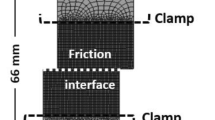Abstract
The performance requirements of steel sheets are becoming increasingly stringent. Inclusions present as non-metallic phases affect the mechanical properties and workability in the down-stream processes of the sheet production adversely. By knowing how the inclusions affect the properties, suitable process parameters can be identified to avoid the defects formation during the forming operations. A very small size of the inclusions necessitates their behavioural study at the micro-scale. This requires a micro–macro modelling approach to identify the effects of the inclusions on forming operations such as hot rolling. In this work, a comprehensive micro–macro model is presented to quantify the effects of the inclusions and their characteristics on the properties of steel during solidification and forming. A micro-model developed using 2-D Finite Element Method is used to study void formation and its evolution at the inclusion/matrix interface (interfacial damage) and stress evolution in and around the inclusions. The model is then employed to study the effects of inclusion properties (hard/soft), its size and shape on the properties of the steel matrix. The constitutive equation for the macro-scale simulation of hot rolling is updated based on the findings of the micro-model. The modified constitutive equation at the macro-scale will allow the choice of a suitable process-parameters regime that will avoid failure during hot rolling and also lead to improved final properties in steel containing inclusions.
Similar content being viewed by others
References
Luo C (2001) Evolution of voids close to an inclusion in hot deformation of metals. Comput Mater Sci 21:360–374
Luo C, Ståhlberg U (2001) Deformation of inclusions during hot rolling of steels. J Mater Process Technol 114:87–97
Yu HL, Bi HY, Liu XH, Tu YF (2008) Strain distribution of strips with spherical inclusion during cold rolling. Trans Nonferrous Metals Soc China 18:919–924
Stiénon A, Fazekasa A, Buffière JY, Vincent A, Daguier P, Merchi F (2009) A new methodology based on X-ray micro-tomography to estimate stress concentrations around inclusions in high strength steels. Mater Sci Eng A 513:376–383
Ghosh A (2001) Secondary steelmaking. CRC, Boca Raton
Eshelby JD (1957) The determination of the elastic field of an ellipsoidal inclusion and related problems. Proc R Soc Lond A Math Phys Sci. doi:10.1098/rspa.1957.0133
Eshelby JD (1959) The elastic field outside an ellipsoidal inclusion. Proc R Soc Lond A Math Phys Sci. doi:10.1098/rspa.1959.0173
Ervasti E, Stahlberg U (2005) Void initiation close to a macro-inclusion during single pass reductions in the hot rolling of steel slabs: a numerical study. J Mater Process Technol 170:142–150
Hwang YM, Chen DC (2003) Analysis of the deformation mechanism of void generation and development around inclusions inside the sheet during sheet rolling processes. J Eng Manuf. doi:10.1243/095440503322617144
Yu HL, Bi HY, Liu XH, Chen LQ, Dong NN (2009) Behavior of inclusions with weak adhesion to strip matrix during rolling using FEM. J Mater Process Technol 209:4274–4280
Yang DX, Xie JP, Zhang KF, Liu ZF, Wang AQ (2009) Numerical simulation of stress field in inclusions of large rudder arm steel castings. China Foundry 6(3):219–225
Prasannavenkatesan R, Zhang J, McDowell DL, Olson GB, Jou HJ (2009) 3D modeling of subsurface fatigue crack nucleation potency of primary inclusions in heat treated and shot peened martensitic gear steels. Int J Fatigue 3:1176–1189
Gupta A, Kumar P, Anapagaddi R, Reddy N, Goyal S, Singh AK, Padmanabhan KA (2013) Integrated modeling of steel refining, casting and rolling operations to obtain design set points for quality steel sheet production. NUMIFORM 2013, AIP Conf Proc. doi:10.1063/1.4806880
Allazadeh MR, Garcia CI, DeArdo AJ, Lovell MR (2009) Analysis of stress concentration around inclusions due to thermally induced strain to the steel matrix. JASTM Int. doi:10.1520/JAI102041
Siegmund T, Brocks W (1999) Prediction of the work of separation and implications to modeling. Int J Fract 99:97–116
ANSYS Release 14.0, Help System, Mechanical APDL, ANSYS, Inc
A MEMS Clearing house® and information portal for the MEMS and Nanotechnology community. http://www.memsnet.org/material/aluminumoxideal2o3bulk/. Accessed on 11 Feb 2013
Bernard G, Ribound PV, Urbain G (1981) Investigation of the plasticity of oxide inclusions. Rev Metall Cah Inf Tech 78:421–433
Dandekar CR, Shin YC (2011) Molecular dynamics based cohesive zone law for describing Al–SiC interface mechanics. Compos A: Appl Sci Manuf 42(4):355–363
Hao S, Liu WK, Moran B, Vernerey F, Olson GB (2004) Multi-scale constitutive model and computational framework for the design of ultra-high strength, high toughness steels. Comput Meth Appl Mech Eng 193:1865–1908
Alfano G, Crisfield MA (2001) Finite element interface models for the delamination analysis of laminated composites: mechanical and computational issues. Int J Numer Meth Eng. doi:10.1002/nme.93
Lasdon LS, Waren AD, Jain A, Ratner M (1978) Design and testing of a generalized reduced gradient code for nonlinear programming. ACM Trans Math Softw 4(1):34–50
Murakami Y (2002) Metal fatigue: effects of small defects and non-metallic inclusions. Elsevier, Amsterdam
Zhang L, Thomas BG (2003) State of the art in evaluation and control of steel cleanliness. ISIJ Int 43(3):271–291
Gautham BP, Singh AK, Ghaisas SS, Reddy SS, Mistree F (2013) PREMΛP—a platform for the realization of engineered materials and products. ICoRD'13, Lecture Notes in Mech. Eng., Chennai. doi:10.1007/978-81-322-1050-4_104
Author information
Authors and Affiliations
Corresponding author
Rights and permissions
About this article
Cite this article
Gupta, A., Goyal, S., Padmanabhan, K.A. et al. Inclusions in steel: micro–macro modelling approach to analyse the effects of inclusions on the properties of steel. Int J Adv Manuf Technol 77, 565–572 (2015). https://doi.org/10.1007/s00170-014-6464-5
Received:
Accepted:
Published:
Issue Date:
DOI: https://doi.org/10.1007/s00170-014-6464-5




